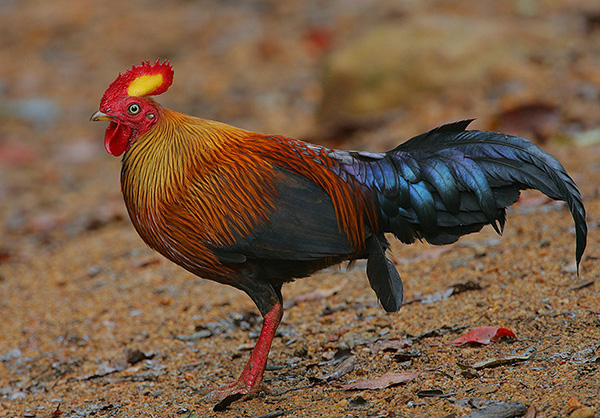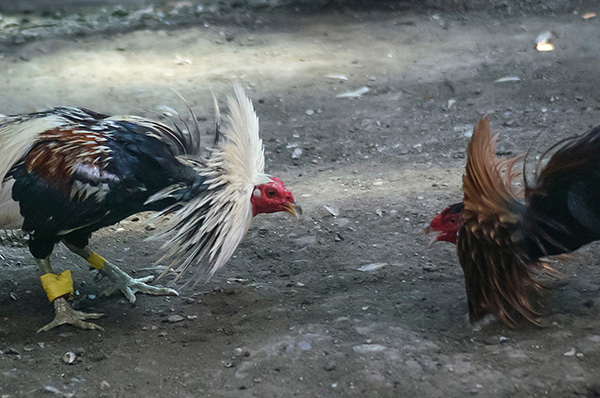
Cockerels tend to have more resplendent and colourful plumage than hens.
THE word ‘cockerel’ appears to have been first used in English in the 15th century.
Later, the American word ‘rooster’, from old English via Dutch, was born. Whatever its origin, the word rooster has stuck in my craw and is especially symbolic this Chinese New Year in our homes.
I wonder how many of us can still remember a traditional childhood nursery rhyme, entitled ‘Cock-a-doodle-do’, apparently sung by English children in the early 17th century but not written down and published until 1765?
To remind readers, the first verse is as follows, “Cock-a-doodle-doo! My dame has lost her shoe, My master’s lost his fiddling stick (violin bow), And doesn’t know not what to do.”
One of my earliest memories was my mother singing a version of this when our next door neighbour’s cockerel crowed. From then to now, I have been plagued with that dawn chorus, with an uncle who specialised in breeding Polish bantam cockerels as show birds, to cockerels crowing in the early light in my retirement in both Kuching and my Somerset home. I must admit, though, that a Kuching neighbour’s natural cockerel ’alarm clock’ never let me down when I had to leave at 6.30am to get to my office whilst working here.
Recently in Somerset, as a night owl in work terms, my morning sleep in has no longer been disturbed by a penetrating crow from next-door’s cockerel. A few weeks ago the cockerel was ‘nabbed’ at night by a marauding fox. I am told that cockerels (belonging to the genus Gallus gallus) are part of the English countryside and its charm.
Roosters are so called because they perch high on a roost for a daytime nap but usually they keep one eye open looking out for any intruders or competitor male chicken that may trespass into their domain and threaten their brood of hens, literally ’ruling the roost’.
To see roosters naturally attack each other is a sight to behold and this spectacle, no doubt, led to staged cockfights in England, over the centuries, where people bet on the winning bird. Malaysia, like the UK, has banned this blood sport. However, it still continues illegally, in both countries, in isolated places in the countryside, where the perpetrators are seldom caught.
Interestingly, cockfights are steeped in Dayak animistic history, where the letting of blood was believed to represent humans becoming the fighting cocks of god. AR Wallace, in his now famous book, ‘The Malay Archipelago’, gives a vivid and gruesome account of the cockfights he observed “almost every day” whilst he was on the Indonesian island of Aru in June 1857.
Today, live roosters are still taken annually, in many parts of the world, to be slaughtered on sacred mountains for the letting of blood as an appeasement to the mountain spirits or their gods. This ritual is regularly performed on Mount Kinabalu by Kadazandusun porters and guides. It has been observed that visitors who abuse the mountain have been justly punished for incurring the wrath of the gods.
Distinctive features
All cockerels begin to crow within four months of hatching and actually can crow at any time of the day – often only to proclaim their territorial rights. Distinguished by their resplendent and often more colourful plumage than the hens, together with their larger red combs, they strut around fields or in their coops with a look of disdain.
To watch a cockerel crow is an image embedded in my mind, for it bends its neck and throws its head up to the skies before expelling air from its lungs for all and sundry to wake up as dawn has approached!

Staged cockfights still continue illegally in many countries.
Legalities of crowing cockerels
In the UK, a crowing cockerel does not commit a Statutory Nuisance Offence to people, other than when it crows for prolonged periods, or with excessive crowing, or crowing at unreasonable hours in the very early morning or late at night. I await to read the first reported prosecution of this Parliamentary Act.
Life in New York City is a different matter for, by federal law there, cockerels are deemed neighbourhood nuisances, yet the keeping of turkeys, geese, hens and ducks is allowed. Roosters are considered to be violations of the law with a US$ 1,000 fine. In 2014 in NYC, 63 per cent of wild animal violations was attributed to roosters!
Roosters in religions
In Judaism roosters are considered to be markers of the passage of time daily and annually since on the Day of Atonement (Yom Kippur), roosters were sacrificed to release man from his sins. In Christianity, all four Gospels record that Jesus Christ foretold that the apostle Simon Peter would deny him three times before the cock crowed. Subsequently, Peter became the first Bishop of Rome (first Pope) and his emblem was that of a cockerel.
A later Pope, Leo IV, installed a figure of a cockerel on St Peter’s Basilica in Rome and even today many churches have a rooster effigy on top of their steeples. It is thought that such ‘weather cocks’ (wind vanes) derived from this faith.
In Islam, the cockerel is considered a divine creature, awakening the faithful like an angel for early morning prayers. In Japan many live roosters are seen around Shinto shrines where they are associated with a sun goddess The Taoist faith relates the cockerel to the ‘yang’ symbol of the sunrise.
Characteristics of human roosters
Somewhat surprisingly, the rooster is the only bird in the Chinese zodiac, occurring in the 10th year of the 12-year cycle. Thus, 2017 is the year of ‘Fire Rooster’ following on from the other five elements associated with each year of the rooster.
Those born in the Year of the Fire Rooster, and their relatives and friends who know them, may realise that some of the alleged common traits are prevalent in a fire rooster’s character. This rooster is distinguished by confidence, motivation, loyalty, and trustworthiness.
Always smartly dressed and honest in passing frank opinions, they do not beat about the bush in offering advice to others. Those roosters who are 60 years of age this year and the newborns supposedly possess energy and burning fire.
May we all celebrate this Chinese New Year with a true sense of anticipation of good health and happiness, not only in our own lives, but also for those less fortunate people in our troubled world. Long may the festival, as part of Malaysian culture, continue with open houses for relatives and friends. Do enjoy your chicken dinners, but ask if the chicken meat came from a hen or a rooster. If the latter, then as my mother used to say, “This is a tough old bird to chew!”
